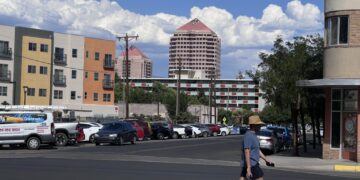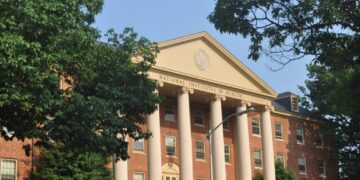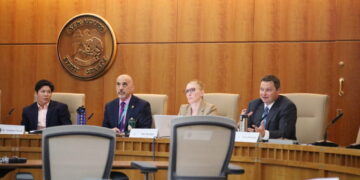

When Gov. Gavin Newsom released his preliminary $322 billion state budget plan in January, he projected a “modest surplus.” But many things have changed since then: A general economic slowdown in the U.S. economy; an estimated decline in income tax revenue due to the stock market fallout from President Donald Trump’s tariffs; and an unprecedented Medi-Cal budget shortfall to name a few.
Now — as Newsom on Wednesday unveiled his updated budget plan — California is facing a $12 billion budget deficit, writes CalMatters’ Alexei Koseff.
Newsom’s budget proposal paints an economic outlook that, at best, is unclear, and at worst, is grim. For instance, Trump’s ongoing tariff policies (which Newsom described in the plan as “remarkably inconsistent”) could have “broad-reaching impacts” on nearly all of the state’s imports and could worsen inflation in California. The state’s job growth is also expected to slow through 2026.
In light of the current and upcoming challenges, Newsom plans to close the gap in a few ways. He still needs legislative approval.
- Walking back Medi-Cal: To save more than $5 billion, Newsom wants to pause new Medi-Cal enrollments for adult immigrants without legal status beginning in 2026 — a rollback Republican legislators have called for. He is also proposing that adults with “certain statuses” (which could still include those with lawful status) pay a $100 monthly premium starting in 2027. Weight loss drugs, such as Ozempic, would no longer be covered as well, which is estimated to save $85 million this year. Read more from CalMatters’ Kristen Hwang and Ana B. Ibarra.
- Closing prisons: California has closed four prisons in recent years, a trend that was enabled by falling numbers of incarcerated people. Newsom wants to close another yet-to-be-determined prison by October 2026, which would save roughly $150 million annually. One big question mark, however: In November, voters passed Proposition 36 to increase penalties for drug- and theft-related crimes. The measure is expected to increase the prison population, though, “we just don’t know how much,” said Newsom on Wednesday. Read more from CalMatters’ Nigel Duara.
- Shifting cap-and-trade funds: California’s landmark cap and trade program — which enables companies to buy and trade climate credits — has provided billions of dollars for projects aimed at combating climate change and other environmental issues for more than a decade. Newsom wants to shift some of that money to pay for Cal Fire operations, as well as at least $1 billion a year to fund the High-Speed Rail project.
Join CalMatters and Evident in Bakersfield on May 21 for a screening of Operation: Return to Sender, a short documentary uncovering what really happened during a three-day Border Patrol raid in Bakersfield. After the film, CalMatters’ Sergio Olmos and others will discuss what the team uncovered and what it means for immigration enforcement. Register today or attend our Los Angeles screening on May 22.
Other Stories You Should Know
Bad news on CA housing

From CalMatters housing reporter Ben Christopher:
For all the optimistic legislation, gubernatorial edicts and state-led lawsuits that the state has aimed at boosting the construction of desperately needed homes, California’s housing market stubbornly refuses to cooperate.
As part of the governor’s revised budget, the administration noted that permits for residential construction are at a decade-long low. Fewer than 100,000 new units were permitted in 2024 — a 10% decline from the prior year. The 2025 numbers so far are coming in even lower than expected.
The future doesn’t look much different. Blaming high interest rates, tariffs and tight labor markets for construction workers, Newsom’s budget wonks projected low permits through mid-2027.
The figures were dragged down by a collapse in proposed apartment projects specifically. That’s despite a bevy of prior bills aimed at promoting dense “infill” urban development.
Will two more bills make a difference? Newsom is counting on it. In Wednesday’s presentation he endorsed two of this year’s most controversial bills (Senate Bill 607 and Assembly Bill 609) that would exempt most urban housing projects from the state’s signature environmental law.
Will freezing building codes make housing more affordable?

Speaking of housing, Ben also takes a look at a bill that seeks to make housing more affordable by putting a multi-year pause on building standards — a proposal critics say is misguided.
If passed, the bill wouldn’t negate any of the current building standards, which dictate a building’s plumbing, safety features, electrical wiring and more. Rather, the measure would freeze the rules in place starting on June 1 through at least 2031. That means that California’s 2025 code, which is set to kick in January 2026, wouldn’t go into effect.
The bill has breezed through the Assembly, likely because its co-author is Assembly Speaker Robert Rivas of Salinas. Proponents say the measure would bring down the cost of construction: Major building standard updates over the last 15 years have added as much as $117,000 to construction costs on each single-family home, according to the California Building Industry Association.
But bill opponents, which include environmental advocates, construction unions and code enforcement officials, argue that the approach is too dramatic of a departure from how the state typically regulates buildings, and that building codes are not the primary cause of high housing costs.
And lastly: Curbing threats to CA schools and churches

California’s Legislature is considering a bill to increase penalties for threats made against schools and places of worship. CalMatters’ Denise Amos and video strategy director Robert Meeks have a video segment on the proposal, which proponents say would help reduce trauma as part of our partnership with PBS SoCal. Watch it here.
SoCalMatters airs at 5:58 p.m. weekdays on PBS SoCal.
California Voices
CalMatters columnist Dan Walters: There’s a good chance that Newsom’s governorship will end with the state’s finances still unbalanced, which will be an immediate problem for his successor.
CalMatters contributor Jim Newton: A unanimous vote earlier this week on an Inland Empire warehouse project signals a sea change in the statewide approach to building more warehouses.
Other things worth your time:
Some stories may require a subscription to read.
Newsom asks lawmakers to fast-track Delta tunnel project // Politico
No cuts for schools, more funding for early literacy, in Newsom’s budget revision // EdSource
How a funding pause and renewed controversies could tank CA’s ethnic studies mandate // Los Angeles Times
This CA county has the highest death rate for climate change-driven wildfire smoke // San Francisco Chronicle
Mystery of ‘exploding birds’ deepens in Richmond as necropsies suggest foul play // ABC 7
Politics watchdog opens probe into contentious election mailer in Fresno // Fresnoland
Officers are winning massive payouts in ‘LAPD lottery’ lawsuits // Los Angeles Times
LA County wildfire alert mistakenly sent to millions due to tech glitch // AP News
This OC Assembly race is already one of the most expensive 2026 legislative contests // The Orange County Register
CA US Rep. asks for surveillance towers along San Diego coast to prevent maritime smuggling // The San Diego Union-Tribune
This post was originally authored and published by Lynn La from Cal Matters via RSS Feed. Join today to get your news feed on Nationwide Report®.


























